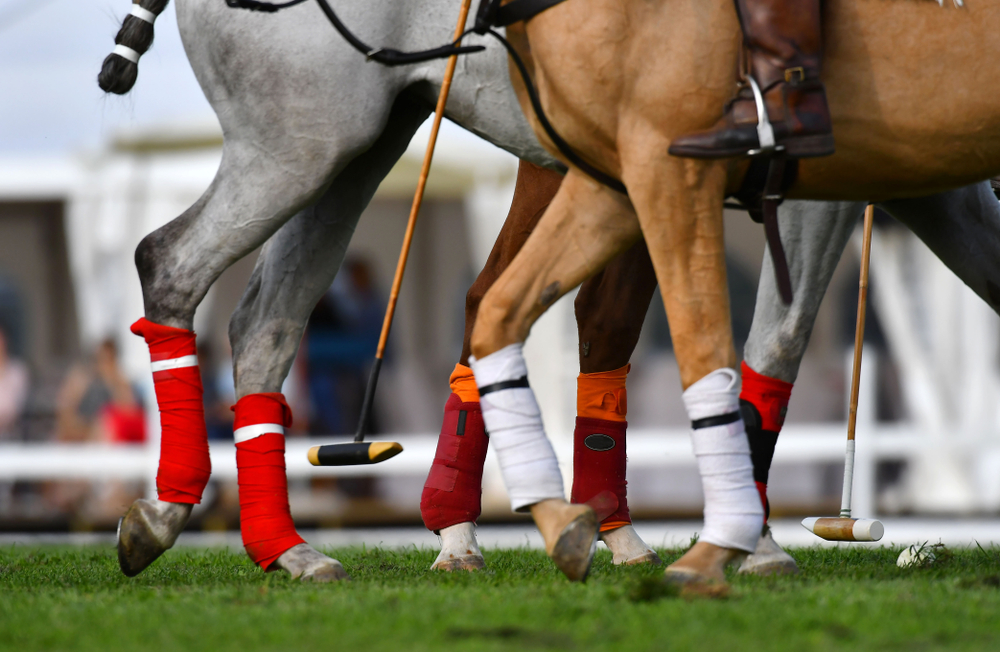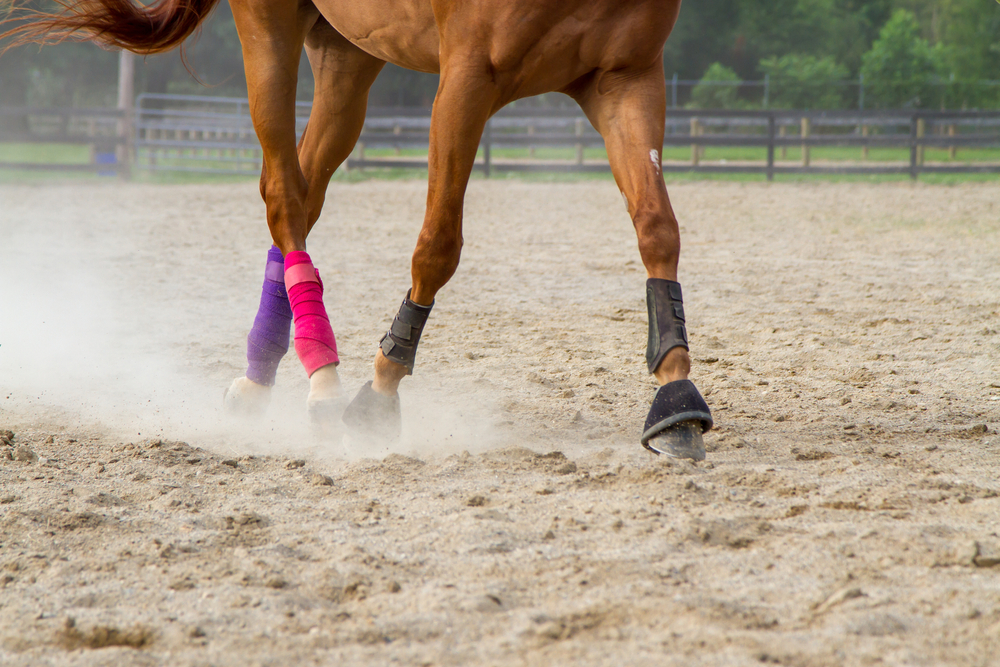- Your source for stall mats, rubber arena footing, arena harrows and arena dust control.

Regardless of whether the stable houses the next Olympic champion or the 28yr old family Shetland, at least one of the yard horses will sport a leg wrap at some point. However, the type of leg wrap modeled by the individual horses depends on the purpose of the wrap.
Leg wraps provide protection from mechanical injuries, support tendons, and ligaments, keep legs clean and control mild edema. There are four basic types of leg wraps used on horses:
- Polo wraps
- Stable wraps
- Modified stable wraps used for medical purposes
- Travel wraps
There are many different types of equine leg wraps, with each kind of wrap being used for a different purpose. It’s essential to understand the when, why, and how of leg wraps to safely and effectively use this valuable horse-management tool.
Polo Wraps And Other Exercise Bandages
Polo wraps, also known as exercise bandages, are used to support the horse’s ligaments and tendons during exercise and provide protection from minor mechanical injuries.
What Types Of Injuries Do Polo Wraps Offer Protection From?
Mechanical injuries that occur during riding or exercising are often due to self-injury, more commonly referred to as interference injuries. Interference injuries refer to all injuries that occurred due to the horse kicking one leg with the other leg.
Abrasions and other friction injuries may also occur due to contact with the ground, such as when a racehorse’s fetlocks touch the ground during acceleration or when a reining horse performs a sliding stop.
When Should I Use Polo Wraps?
Polo wraps are most beneficial when riding big moving young horses or horses doing fast turns, rapid accelerations, and high-impact activities.
The types of horses that benefit from polo wraps:
- Big moving horses, e.g., young dressage horses, who often over-reach and clip their adjacent legs because they don’t have the balance and muscle strength necessary to control their naturally extravagant movement.
- Narrow-chested horses and horses who daisy cut. Horses with these conformational and movement flaws are more likely to knock one front leg with the adjacent front leg.
- Horses with bowed tendons or dropped fetlocks will benefit from support.
*Daisy cutting refers to movement flaw where the horse’s front leg swings out during the swing phase of gait.
Activities requiring leg protection in the form of polo wraps:
- Reining patterns or training in which sliding stops and spins are part of the workout.
- High-level dressage involving lateral work, flying changes, piaffe, pirouette, and passage
- Jumping for extended periods or jumping high jumps
- Racing
When Shouldn’t I Use Polo Wraps?
It’s not always beneficial to use polo wraps on your horse, i.e., a healthy horse doing low-intensity training doesn’t need polo wraps. The heat generated under the wrap during work outweighs the benefits of using leg wraps in leisure riding horses.
Polo wraps should never be used on trail horses. Burs, brambles, and other plant matter will become stuck to the fleece polo wraps, creating an itchy leg covering guaranteed to annoy your horse and put him in a bad mood. Boots are often a better option for trail horses than polo wraps.
Eventers, marathon carriage drivers, and le trec riders working through water obstacles would all do better with boots than polo wraps. Polo wraps quickly become waterlogged and take a long time to dry. The wraps will either fall off or cause skin irritation when soaked in water.
Polo wraps are applied with greater tension than stable bandages and should be removed after every workout. Failure to remove the wrap can result in compromised blood and lymph circulation in the horse’s lower legs.
What Types Of Polo Wraps Are Available?
Polo wraps are made from long rectangular strips of mildly stretchy fleece attached with a Velcro fastening. The wraps may also be made from a highly elastic cotton-lycra material.
The fleece bandages are more skin-friendly than the cotton-lycra bandages, but the highly elastic cotton-lycra bandages offer more support.
Some bandage brands offer a half-and-half bandage, thus providing the best of both worlds. The first half of the wrap is fleece, and this part is the part that comes in contact with the horse’s skin. The second half is elastic cotton-lycra that wraps over the fleece portion of the bandage.
All polo wraps extend from the bottom of the knee or hock and reach down to the bottom of the fetlock.

Stable Wraps
Stable wraps, also known as standing wraps, are used in the stable to provide:
- Warmth to cold legs
- Protection from bumps and knocks that may occur in the stable
- To control mild swelling
- To keep white legs clean
Stable wraps should never be left on for more than eight consecutive hours. It’s essential to remove the bandage regularly to ensure that the leg is not overheating and that the bandage is not causing any pressure injuries.
A horse living outside should not wear stable bandages, as they can tighten and slip if they become wet.
How Are Stable Wraps Applied?
Stable wraps differ from polo wraps in the fact that they are only ever made of fleece. Elastic bandages would damage the leg if worn for more than an hour or two.
A filler material is used to provide padding when applying stable bandages. Two materials commonly used for padding: fybagee (felt/foam) and quilted cotton pads.
The padding material is applied first to protect bony points from pressure injuries, and then the fleece bandage is wrapped around the pads.
A stable bandage may extend from the bottom of the knee or hock to the bottom of the fetlock or the coronet band at the top of the hoof. The owner’s personal preference determines the length of the bandage.
Stable bandages should always be applied symmetrically, i.e., both front legs, both back legs, or all four legs. It should never be used unilaterally on only one leg.
Alternative Uses For Stable Wraps
Stable wraps can perform several different medical functions if minor alterations are made to the standard stable bandage:
- A stable wrap helps hold a medical bandage in place if the horse has a nasty laceration or open infection.
- The application of an elastic bandage over the stable wrap is used to splint or immobilize an injured leg promoting healing and controlling pain.
This bandaging arrangement has also been used to control more extensive swelling. However, this technique should only be used under the guidance of a vet, as it can have serious complications if misapplied.
- Overheated legs and legs with active inflammation are cooled down by applying frozen fybagee pads held in place by the stable wrap. The cold fybagee pads should be removed after 20 minutes and reapplied every hour to control aggressive inflammation.
Travel wraps
Travel wraps and shipping wraps perform a similar function to stable wraps. The only significant difference between shipping wraps and stable wraps is that a shipping wrap ALWAYS extends over the coronet band at the top of the hoof.
All horses benefit from leg protection when traveling. Traveling in a horsebox can be a considerable balance challenge for any horse. Many horses are injured by their travel companions accidentally stepping on them or by stumbling or falling in the horsebox.
Modern travel boots offer superior leg protection than shipping bandages and are much easier and quicker to put on and take off.
Conclusion
The four basic types of leg wraps are an essential tool for any horse owner. Polo wraps, standard stable wraps, and shipping wraps are used prophylactically to prevent injury.
Modified stable bandages can be used to treat various medical conditions relating to the horse’s lower legs.
Use leg wraps with caution as they can damage the horse if misapplied or misused.
Sources
- https://www.youtube.com/watch?v=GicfRy-70V4

- https://www.canr.msu.edu/news/how-to-protect-your-horses-legs

- https://www.youtube.com/watch?v=4ZEk58w_cFM

- https://www.youtube.com/watch?v=meVfdZavNYA

- https://www.thesprucepets.com/choosing-leg-wraps-or-bandages-1886226

- https://thehorse.com/115469/horse-bandaging-fundamentals/


